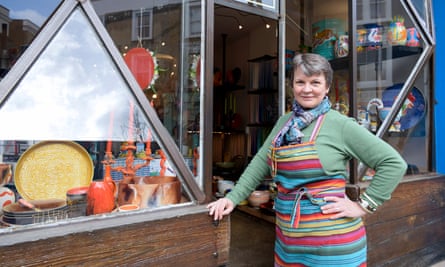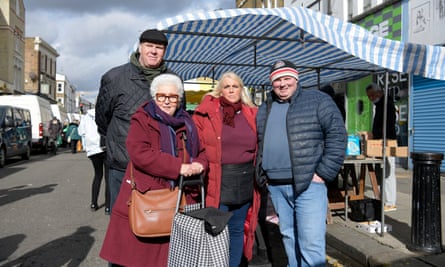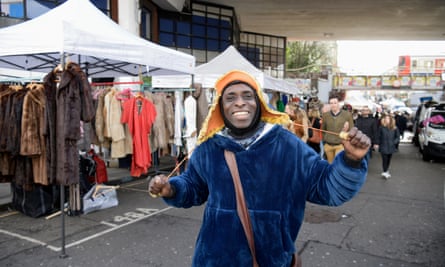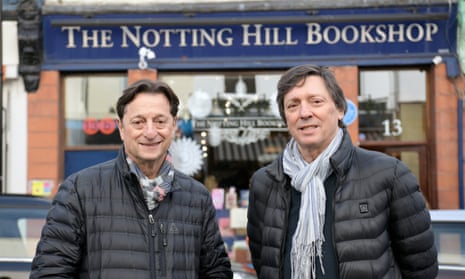She was only a girl, standing in front of a boy asking him to love her, but would Anna Scott and William Thacker recognise the Notting Hill that exists today, 25 years on from their fictional meet-cute?
Parts of the west London district in which the film was set were down at heel and bohemian – a far cry from much of today’s Notting Hill, where it was revealed this week residents received more in capital gains from 2015 to 2019 than the combined populations of Liverpool, Manchester and Newcastle.
Many of the features that gave the area its charm in the film still exist: the rows of pastel-coloured Georgian townhouses, the bustling Portobello market, the plethora of independent businesses.
Yet intense gentrification has also changed Notting Hill – and planned redevelopment of the famous Portobello Road market could alter its character irrevocably, local business owners and market traders said.

Arguably the neighbourhood’s best-known business is the Notting Hill Bookshop, where famous actor Anna Scott, played by Julia Roberts, first encounters local bookseller William Thacker, played by Hugh Grant. It’s now owned by Howard Malin, who has lived in the area for 40 years and has watched it “change a lot”.
“As with much of inner London, as it becomes more gentrified the artistic community gets pushed further out because of affordability issues. Twenty-five years ago this was quite edgy, there was a strong Caribbean influence – more so than now: very artistic, a little bit bohemian.
“The influence of the film was dramatic and the area became very rapidly gentrified, within about 18 months. I think property values jumped by a quarter, it was insane. It became very yummy mummy, very desirable. It put Notting Hill on the map.”
He thought the appeal was due to the good schools, green spaces, large houses, proximity to the West End and connections to Heathrow and the Cotswolds.
Although the film came out in 1999, tourists still flock to the bookshop, which Malin said had hosted a steady stream of proposals over the past two decades.
Despite the influx of wealthy residents, the area has retained much of its old spirit, including longstanding artisan businesses and Portobello Road stallholders, he said.

Across the road, Lindy Wiffen, who opened pottery store Ceramica Blue in 1987, agreed: “This block [has changed] probably less than most of the neighbourhood, because some of the businesses that were here before me still exist. There are people from all walks of life side by side. The market is the heart and soul of the neighbourhood. It’s a really interesting mix, there’s great characters.”
But she said that an increasing influx of tourists, especially since the pandemic, has resulted in more “soulless and generic” souvenir shops, and lower profits as many come just to take photographs. She now sells more smaller, cheaper items, which can be taken home in suitcases.
Wiffen worries that the council doesn’t always recognise the contribution made by local businesses: “Decisions are made from on high without talking to grassroots people.”
Her view was echoed by several market traders, who are concerned by proposals to overhaul Portobello market. Ellis Jenkins, who started working on his grandfather’s pitch aged seven, said: “The council are looking to revamp this market and gentrify it, remove all the character from it.”
Kensington and Chelsea’s deputy leader, Kim Taylor-Smith, said: “We’re incredibly proud of Portobello market and its heritage, character and rich diversity. Our investment aims to celebrate this award-winning market and enhance the experience while remaining true to Portobello’s unique charm.
“We are looking to improve trading conditions and, together with the community, find solutions to strengthen Portobello Road for generations to come.
“We frequently communicate with traders, residents and businesses to hear their thoughts before decisions are made and thank them for contributing.”
There are other threats to the market’s future. Although Jenkins’ wife, Lisa, is a fifth-generation market trader, their children don’t want to continue the business because of the long hours, cold days, hotter summers and a wider array of alternatives.

Mark Barr, a market trader for 35 years and former chair of Portobello and Golborne management committee, said discussions around getting rid of van parking could result in the market’s decline, as has happened in other areas. “Nobody wants that but it seems to be a small group of big landlords who feel their property prices would go up if there was no market.”
Marion Gettleson, a local person who ran a Portobello Road antiques shop for 50 years, said the plans were “an absolute shortcut to destroying this market” and would further push out poorer people from an unaffordable borough with a declining population. “The council wants a sea of tranquility where everyone is paying 40% income tax because they don’t need public services.”

This picture is a long way from the Notting Hill that Frank Akinsete, who has run vintage shops and market stalls for 35 years, recalls when he first came to carnival aged 16 and “felt like I had walked into bohemia”.
He has been disappointed to watch the neighbourhood change. “If you come here in the week it’s quite sterile. It’s still special but it’s not what I bought into – very diverse, very free.”
He also attributes gentrification to the film. “It’s a case of life imitating art because when the film came, people like me who lived here locally, we used to take the piss out of it and think: ‘Bloody hell, Julia Roberts and Hugh Grant? You must be joking.’ But slowly it attracted a different client base.
“After the film, the prices going up pushed out a lot of the working-class community. Rich people, trustafarian types, they’d come and say: ‘Oh, it’s really cool here,’ but then they’d make it like Chelsea or Fulham.”
But he has found ways to make the most of the changes: “When I was young and naughty, when people came asking for the blue door [featured in the film] I used to send them to Trellick Tower, because it was really rough up there. Now it’s a heritage site.
“The gentrification has served me well. I made a lot of money out of property. I can’t be a hypocrite, but it’s shocking what you could have bought here before. Golborne Road was the last bastion and now that’s all chichi.”










